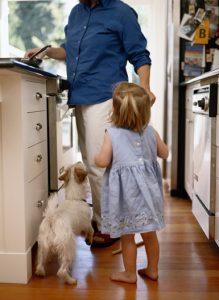Follow these tips to help your pet adjust to the arrival of a new baby

Helping your pet adjust to the arrival of a new baby is much like preparing a young child for the same event. Handling your pet’s curiosity, anxiety and increased insistence for attention may seem overwhelming, especially in addition to preparing for the baby’s arrival. However, you can help your pet adjust to the big change with minimal time and effort by making gradual adjustments to your lifestyle before the baby arrives.
How will my pet react?
No matter how much you plan ahead, the addition of a new family member may be difficult for your pet. Remember, your dog or cat was your first “baby” and is used to being the center of attention. It is understandable that she may experience something akin to sibling rivalry when you introduce a new baby into your house.
Minimize this feeling by taking steps now to gradually get your pet used to the new routine that will be in place when the baby comes home. Suddenly decreasing attention and exercise – plus frequently scolding, ignoring or isolating your pet when the baby arrives will make your pet feel stressed and associate bad changes with the baby’s arrival.
If your pet is particularly attached to one family member, other family member(s) should develop a closer relationship and step up to help play with, exercise, and spend time with him. That way, your pet can still feel loved and provided for while the primary caretaker is busy with the baby.
How can I prepare my pet?
Below are several suggestions to make introducing your pet and baby safer and smoother for all. Be sure to carry out these changes months before the baby’s arrival to best prepare your pet.
- Accustom your pet to baby-related noises months before the baby arrives. Play recordings of a baby crying, turn on the mechanical infant swing and use the rocking chair. Make these positive experiences for your pet by offering a treat or playtime when the “baby” cries or after each swing.
- Allow your pet to thoroughly investigate and sniff around the baby’s room with all the new items in it to take away the curiosity and need to go in there.
- If the baby’s room will be off limits to your pet, install a sturdy barrier such as a dog gate or screen door. This barrier will still allow your pet to see and hear what’s happening in the room, so he’ll feel less isolated from the family and more comfortable with the new baby noises.
- Carry around a swaddled baby doll, take the doll in the stroller when you walk your dog, and use the doll to get your pet used to routine baby activities, such as bathing and diaper changing. Let your pet get used to your voice talking to the baby — using the baby’s name if you’ve selected one.
- With total adult supervision, you could ask family and friends with infants to visit your home to accustom your pet to babies. Your dog should be on leash. You must closely supervise all pet and infant interactions.
- Sprinkle baby powder or baby oil on your skin so your pet becomes familiar with the new smells.
- If your pet’s behavior includes gentle nibbling, chasing, pouncing or swatting at you or others, redirect that behavior at appropriate objects such as toys and not your hands or feet.
- Train your pet to remain calmly on the floor beside you or, if small, until you have invited him into your lap.
- Plan ahead to ensure your pet is receiving enough exercise after the baby’s arrival; this will help their ability to cope with a likely decrease in attention.
- Increase your pet’s independent activities, such as feeding him out of food dispensing toys.
- Get him used to being fed in a separate area or somewhere the baby cannot crawl to.
- Get your pets groomed and their nails trimmed.
- Address any pet behavior problems. If your pet exhibits fear and anxiety, now is the time to get help.
- Consult with a veterinarian, pediatrician and/or animal behavior specialist if the thought of a newborn interacting with your family pet makes you uncomfortable. By working with these experts before your baby is born, you can resolve problems early.
- Plan ahead to make sure your pet gets proper care and exercise while you’re at the birthing center and when you first return home.
What do I do after the baby is born?
Before you bring your baby home from the hospital, have your partner or a friend take home something with the baby’s scent (such as a blanket) for your pet to investigate.
When you return home from the hospital, your pet may be eager to greet you and receive your attention. Have someone else take the baby into another room while you give your pet a warm, but calm, welcome. Keep some treats handy so you can distract your pet. After the initial greeting, you can bring your pet with you to sit next to the baby; reward your pet with treats for calm and relaxed behavior. Remember, you want your pet to view associating with the baby as a positive experience. To prevent anxiety or injury, never force your pet to get near the baby. Always carefully supervise any interaction.
Life will no doubt be hectic caring for your new baby, but try to maintain regular routines as much as possible to help your pet adjust. And be sure to spend one-on-one quality time with your pet each day — it may help relax you, too. With proper training and supervision, you, your new baby and your pet should be able to live together safely and happily as a family.
Questions about pet training and behavior? Call our free pet behavior help line at (503) 416-2983.
 Tanya Roberts is the Senior Manager of the OHS Training & Behavior Department and a Certified Professional Dog Trainer (CPDT-KA). Tanya continues her education by attending seminars and trainings so she can provide clients with current, scientifically-based information. Her best teachers continue to be the wonderful animals at the Oregon Humane Society, who she works with regularly during their stay.
Tanya Roberts is the Senior Manager of the OHS Training & Behavior Department and a Certified Professional Dog Trainer (CPDT-KA). Tanya continues her education by attending seminars and trainings so she can provide clients with current, scientifically-based information. Her best teachers continue to be the wonderful animals at the Oregon Humane Society, who she works with regularly during their stay.


